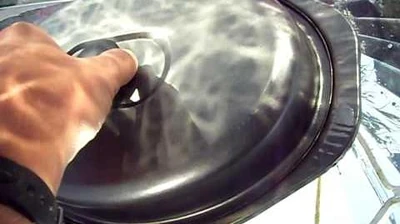Tom Sponheim (talk | contribs) |
Paul Hedrick (talk | contribs) mNo edit summary Tag: sourceedit |
||
| (26 intermediate revisions by 4 users not shown) | |||
| Line 1: | Line 1: | ||
{{GoogleTranslateLinks}} |
{{GoogleTranslateLinks}} |
||
| ⚫ | |||
| + | <table cellspacing="2"><tr> |
||
| + | <td valign="top" width="45%">__TOC__</td> |
||
| + | <td valign="top" width="55%" style="padding:10px;"> |
||
| ⚫ | |||
| ⚫ | More than 85,000 refugees from [[Bhutan]] have been solar cooking their meals in a [[Beldangi Refugee Camp|refugee camp]] in Nepal. The [[Vajra Foundation Holland]] (Stichting Vajra) has worked in the Bhutanese [[refugee camps]] in Nepal since 1995 to bring solar cooking and [[heat-retention cooking]] to the refugees there. By 2013 some 85,000 refugees were cooking their meals using these methods. The on-the-ground work is done by [[Vajra Foundation Nepal]] and financing is provided by the Dutch Lottery and the Dutch NGO [[Stichting Vluchteling]]. |
||
| ⚫ | |||
| ⚫ | |||
| + | </td></tr></table> |
||
==Events== |
==Events== |
||
| + | {{NepalEvents}} |
||
{{CalendarAndPastEvents}} |
{{CalendarAndPastEvents}} |
||
| ⚫ | |||
| − | =={{FeaturedProjectTitle}}== |
||
| + | [[File:Godavari,_Nepal_map,_9-21-15.png|thumb|300px|map by Sci Dev Net]] |
||
| ⚫ | |||
| + | *{{NewSep15}}'''September 2015: Haven of simple technology for mountain living''' - The International Centre for Integrated Mountain Development showcasing solar technologies is located in the village of Godavari in southern Kathmandu. Although solar dryers are widespread across Asia, “the most commonly used solar technology is the solar cooker”, Samden Lama Sherpa, knowledge park officer, tells SciDev.Net. [http://www.scidev.net/global/farming/multimedia/haven-simple-technology-mountain-living-innovation.html Read more...] |
||
| ⚫ | |||
| + | [[File:Nepal-School-Demo-2015-06.jpg|thumb|300px|''Photo: S. Kaji, Director of FoST, Nepal. 2015'']] |
||
| ⚫ | |||
| + | *{{NewSep15}}'''June 2015:''' Nepalese students discovered ways to cook food and [[pasteurize water]] with free solar energy after the earthquake in a demonstration put on by [[Foundation for Sustainable Technologies]] with funding from [[Solar Cookers International]]. |
||
| + | |||
| + | *'''April 2015:''' On 25 April 2015, a magnitude 7.8 earthquake struck 77km (48mi) northeast of Kathmandu in Nepal. As of 27 April, 4000 people have died and over 7000 have been injured in Nepal, China and India. In response to many inquiries regarding this event, SCI has published [http://www.solarcookers.org/what/disaster-preparedness/ Solar Cookers International’s Work for Disaster Preparedness]. |
||
| + | |||
| + | [[File:Sun_and_Ice_-_500_solar_cooker_Nepal.jpg|thumb|300px|One of the 500 parabolic solar cookers manufactured in [[Nepal]] in 2014 with the help of [[Sun and Ice]].]] |
||
| + | *'''November 2014:''' [[Sun and Ice]] reports that it has helped with the manufacture of 500 [[parabolic solar cooker]]s in [[Nepal]] in 2014. They provided the reflector panels, and the support frameworks were built on-site in Nepal. The solar cookers are used by families on the outskirts of Pokhara (second largest city in Nepal). |
||
| ⚫ | |||
[[File:PRINCE_solar_cookers_at_Solar_Trek,_Nepal,_2013.jpg|thumb|300px|PRINCE solar cookers are along on the first ever Solar Trek through the Himalayas in [[Nepal]].]] |
[[File:PRINCE_solar_cookers_at_Solar_Trek,_Nepal,_2013.jpg|thumb|300px|PRINCE solar cookers are along on the first ever Solar Trek through the Himalayas in [[Nepal]].]] |
||
*'''November 2013: PRINCE solar cookers packed for Solar Trek 2013''' - The [[PRINCE - 15]] and the [[PRINCE - 40]] [[parabolic solar cooker]]s, designed by [[Ajay Chandak]], were taken along to prepare meals on the first ever Solar Trek through the Himalayas in [[Nepal]]. |
*'''November 2013: PRINCE solar cookers packed for Solar Trek 2013''' - The [[PRINCE - 15]] and the [[PRINCE - 40]] [[parabolic solar cooker]]s, designed by [[Ajay Chandak]], were taken along to prepare meals on the first ever Solar Trek through the Himalayas in [[Nepal]]. |
||
| Line 48: | Line 61: | ||
*'''March 2006:''' [[Vajra Foundation Nepal]] (VFN), in partnership with United Nations High Commissioner for Refugees ([[UNHCR]]), will receive over $850,000 from Dutch Postcode Lottery to expand its solar cooker program to six additional Bhutanese refugee camps. VFN’s first project, launched in 1998, has benefited over 2,000 families in Beldangi refugee camp. The expanded program will allow refugees to make nearly 7,500 solar cookers, to be used on a shared basis by over 14,000 families. Each family will also receive two cooking pots and a [[Heat-retention cooking|retained-heat cooker]]. [[Stichting Vluchteling]] and [[Vajra Foundation Holland]] helped procure funds. |
*'''March 2006:''' [[Vajra Foundation Nepal]] (VFN), in partnership with United Nations High Commissioner for Refugees ([[UNHCR]]), will receive over $850,000 from Dutch Postcode Lottery to expand its solar cooker program to six additional Bhutanese refugee camps. VFN’s first project, launched in 1998, has benefited over 2,000 families in Beldangi refugee camp. The expanded program will allow refugees to make nearly 7,500 solar cookers, to be used on a shared basis by over 14,000 families. Each family will also receive two cooking pots and a [[Heat-retention cooking|retained-heat cooker]]. [[Stichting Vluchteling]] and [[Vajra Foundation Holland]] helped procure funds. |
||
| − | ==Climate, |
+ | ==Climate, culture, and special considerations== |
[[Solar Cookers International]] has rated Nepal as the #12 country in the world in terms of solar cooking potential (See: [[Media:25_countries_with_most_solar_cooking_potential.pdf|The 25 countries with the most solar cooking potential]]). The estimated number of people in Nepal |
[[Solar Cookers International]] has rated Nepal as the #12 country in the world in terms of solar cooking potential (See: [[Media:25_countries_with_most_solar_cooking_potential.pdf|The 25 countries with the most solar cooking potential]]). The estimated number of people in Nepal |
||
| Line 81: | Line 94: | ||
Solar, the German distributor of these models, on trekking trails in the Mt. Everest area, in Sagarmatha National Par, and a number of schools. The same type of parabolic is in use in Dhullikhel Hospital in Katmandu, where four such units provide hot water for patients. |
Solar, the German distributor of these models, on trekking trails in the Mt. Everest area, in Sagarmatha National Par, and a number of schools. The same type of parabolic is in use in Dhullikhel Hospital in Katmandu, where four such units provide hot water for patients. |
||
| − | In 1994, an organization from Finland, |
+ | In 1994, an organization from Finland, Technology for Life, conducted a series of solar experiments and evaluations of their potential for Nepal. Their search was for devices which would fit the needs of "near-subsistence" economies such as Nepal. They tried box cookers and home made parabolics but found that the cdst of all was out of reach of many, as poor quality was not acceptable and good quality not affordable. Not a dilemma found only in Nepal, but a rather common scenario. |
Another group is also at work in Nepal, the [[Foundation for Sustainable Technologies]] (FoST). This group is a recently established NGO with the goal of widely promoting and disseminating sustainable technologies to improve the quality of life of Nepalese people. They support a wide range of solar technologies and some others such as the haybox and fuel efficient stoves. Quickly after their founding, some of the members were setting up demonstrations in various parts of the country. Their goals are ambitious and long range in nature. However, the organization is too new to-have as yet much of a track record. |
Another group is also at work in Nepal, the [[Foundation for Sustainable Technologies]] (FoST). This group is a recently established NGO with the goal of widely promoting and disseminating sustainable technologies to improve the quality of life of Nepalese people. They support a wide range of solar technologies and some others such as the haybox and fuel efficient stoves. Quickly after their founding, some of the members were setting up demonstrations in various parts of the country. Their goals are ambitious and long range in nature. However, the organization is too new to-have as yet much of a track record. |
||
| Line 102: | Line 115: | ||
*'''August 2014:''' |
*'''August 2014:''' |
||
::[[File:Humanist Community Forum (2014-08-24) Solar Cooking and Other Green Technology Projects in Nepal (Allart Ligtenberg)|thumb|none|400px|In 1992, [[Allart Ligtenberg]] retired early from his Hewlett-Packard engineering manager’s job to follow his dream of disseminating solar cooking/[[water pasteurization]] and other renewable energy technologies in developing countries. Allart started long-term solar cooking programs in Nepal, and each year he spends 2-3 months in Nepal to follow up on these programs.]] |
::[[File:Humanist Community Forum (2014-08-24) Solar Cooking and Other Green Technology Projects in Nepal (Allart Ligtenberg)|thumb|none|400px|In 1992, [[Allart Ligtenberg]] retired early from his Hewlett-Packard engineering manager’s job to follow his dream of disseminating solar cooking/[[water pasteurization]] and other renewable energy technologies in developing countries. Allart started long-term solar cooking programs in Nepal, and each year he spends 2-3 months in Nepal to follow up on these programs.]] |
||
| + | |||
| + | *'''July 2014:''' |
||
| + | ::[[File:Ligtenberg- Nepal Projects Sustainable development One Village at a Time|thumb|none|400px]] |
||
| + | |||
| + | *'''July 2014:''' [[Alan Bigelow]]'s presentation "Solar Cooking on a Trek in Nepal" delivered at the SCInet convention in July, 2014 included the video below. |
||
| + | ::[[File:Bigelow Solar Trekking-0|none|400 px]] |
||
*'''August 2013:''' |
*'''August 2013:''' |
||
| Line 107: | Line 126: | ||
*'''February 2010:''' |
*'''February 2010:''' |
||
| − | ::[[File:Solar Cooking Project in Nepal by Stichting Vajra.wmv-0|thumb|none|400px|Solar cooking project in a Bhutanese refugee camp in 2007 with [ |
+ | ::[[File:Solar Cooking Project in Nepal by Stichting Vajra.wmv-0|thumb|none|400px|Solar cooking project in a Bhutanese refugee camp in 2007 with [http://solarcooking.org/m.]] |
*'''January 2009:''' |
*'''January 2009:''' |
||
| Line 115: | Line 134: | ||
===Articles in the media=== |
===Articles in the media=== |
||
* '''March 2013:''' [http://www.mercurynews.com/mike-cassidy/ci_22798863/cassidy-hewlett-packard-alum-sets-out-change-world Hewlett-Packard alum sets out to change world with Nepal solar project] - ''MercuryNews.com'' |
* '''March 2013:''' [http://www.mercurynews.com/mike-cassidy/ci_22798863/cassidy-hewlett-packard-alum-sets-out-change-world Hewlett-Packard alum sets out to change world with Nepal solar project] - ''MercuryNews.com'' |
||
| + | |||
| + | ===Disaster Assistance Files and Links=== |
||
| + | *'''April 2014:'''[[Media:Kvar-blokoj-forno.pdf|Four-Block Stove (चार ब्लक चुलो)]] - Printable one-page plans for the construction of a rocket stove out of concrete blocks. |
||
{{CountryContacts}} |
{{CountryContacts}} |
||
{{InterwikiLinks|Népal}} |
{{InterwikiLinks|Népal}} |
||
| Line 121: | Line 143: | ||
[[Category:Countries]] |
[[Category:Countries]] |
||
[[Category:Countries with the greatest solar cooking potential]] |
[[Category:Countries with the greatest solar cooking potential]] |
||
| + | [[Category:Nepal]] |
||
Revision as of 17:38, 21 September 2015
|
Last edited: 21 September 2015
|
 Bhutanese refugees demonstrating parabolic solar cookers in Nepal. More than 85,000 refugees from Bhutan have been solar cooking their meals in a refugee camp in Nepal. The Vajra Foundation Holland (Stichting Vajra) has worked in the Bhutanese refugee camps in Nepal since 1995 to bring solar cooking and heat-retention cooking to the refugees there. By 2013 some 85,000 refugees were cooking their meals using these methods. The on-the-ground work is done by Vajra Foundation Nepal and financing is provided by the Dutch Lottery and the Dutch NGO Stichting Vluchteling. |
Events
Featured international events
- 4-6 June 2024 (Bridgetown, Barbados): Sustainable Energy for All Global Forum - The event will be co-hosted by Sustainable Energy for All (SEforALL) and the government of Barbados. It is a platform for government, business and finance leaders, entrepreneurs, and youth and community representatives from around the world to come together to broker new partnerships, spur new investment, and address challenges at the nexus of energy, climate, and development. More information...
Online events
- NEW: Thursday, 18 April 2024 (2:30pm-3:15pm EDT), (Washington, D.C., USA): ESMAP Spring Meetings Knowledge Café: Clean Cooking at the Heart of Energy Access - Join ESMAP for this exciting knowledge-sharing opportunity, which will showcase the role of clean cooking as a key part of energy access and energy transition. Presentations by René van Hell, Director of Inclusive Growth, Ministry of Foreign Affair, Netherlands, Dr. Kandeh Yumkella Chairman, Presidential Initiative on Climate, Renewable Energy and Food Security, Sierra Leone, and Chandrasekar Govindarajalu, Practice Manager, ESMAP, World Bank. In-person attendance at World Bank Atrium, MC Front Lobby is for Spring Meetings registrants only. However, you can watch the event online
Requests for proposal
- Decentralized Renewable Energy Solutions utilizing Solar and Bio-Energy - Sustainable Energy Technologies and Assessments of ScienceDirect, is requesting guest-author submissions. The special issue, VSI: DRES is devoted to publishing research articles reporting the innovative designs and design interventions in solar thermal and bio-energy for decentralized energy systems (DES). It includes i) new and novel designs of prototype or commercial devices and technologies, their development, modeling and simulations and experimental validation; ii) innovations for processes, techniques, utilization, and applications; iii) novel use of materials for improving efficiency, performance, techno-economic feasibility, and sustainability and iv) research findings addressing the socio-economic, health and safety impacts, and life cycle assessments leading to proposing novel devices for DES. The Deadline for submission is 31 July 2024. More submittal information...
- See also: Global Calendar of Events and past events in Nepal
News and recent developments
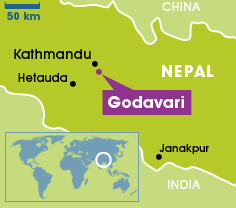
map by Sci Dev Net
- September 2015: Haven of simple technology for mountain living - The International Centre for Integrated Mountain Development showcasing solar technologies is located in the village of Godavari in southern Kathmandu. Although solar dryers are widespread across Asia, “the most commonly used solar technology is the solar cooker”, Samden Lama Sherpa, knowledge park officer, tells SciDev.Net. Read more...
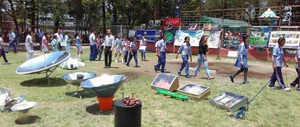
Photo: S. Kaji, Director of FoST, Nepal. 2015
- June 2015: Nepalese students discovered ways to cook food and pasteurize water with free solar energy after the earthquake in a demonstration put on by Foundation for Sustainable Technologies with funding from Solar Cookers International.
- April 2015: On 25 April 2015, a magnitude 7.8 earthquake struck 77km (48mi) northeast of Kathmandu in Nepal. As of 27 April, 4000 people have died and over 7000 have been injured in Nepal, China and India. In response to many inquiries regarding this event, SCI has published Solar Cookers International’s Work for Disaster Preparedness.
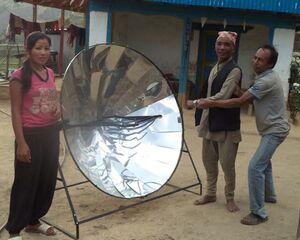
One of the 500 parabolic solar cookers manufactured in Nepal in 2014 with the help of Sun and Ice.
- November 2014: Sun and Ice reports that it has helped with the manufacture of 500 parabolic solar cookers in Nepal in 2014. They provided the reflector panels, and the support frameworks were built on-site in Nepal. The solar cookers are used by families on the outskirts of Pokhara (second largest city in Nepal).
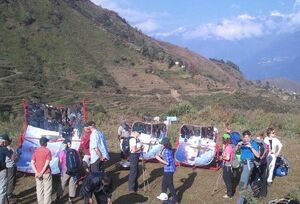
PRINCE solar cookers are along on the first ever Solar Trek through the Himalayas in Nepal.
- November 2013: PRINCE solar cookers packed for Solar Trek 2013 - The PRINCE - 15 and the PRINCE - 40 parabolic solar cookers, designed by Ajay Chandak, were taken along to prepare meals on the first ever Solar Trek through the Himalayas in Nepal.
- October 2013: The Vajra Foundation Nepal reports that recently approximately one third of the Bhutanese refugees have left the camps and found new homes in the USA, Australia, New Zealand, and the European Union. They have left their solar cookers behind, thus freeing these up to be made available to the Nepali families who live around the camps. Devi Maya Kadariya, a resident of the village of Garamani, reports that she and her neighbors had seen the profile of the solar cookers in the distance and they knew that the refugees were able to cook with the sun. She now considers herself lucky to have a solar cooker for herself. She says she saves a lot of wood and especially saves the time that she used to spend gathering wood, and she feels that her life is better now.
- September 2013: Klaus Schulte reports his personal involvement with the Rotary International project to provide 120 SK-14 parabolic solar cookers in the village Bamti Bhandar, Nepal ended in 2003. The solar cookers are still in use, and the total number of cookers is now over 135. He hopes, that tourists who are trecking on the Mount Everest road through the village can see and get information about how well the cookers are working. Read more at: Ten years with Energy Hunters of Nepal in Bamti Bhander 2013 - Klaus Schulte
- August 2013: Partnering in Nepal to promote integrated cooking Solar Cookers International began a partnership with the Foundation for Sustainable Technologies (FoST), in Nepal in August 2013. Like SURE and FOTO, FoST benefits stressed families living in environments that are deforested. The FoST program empowers single mothers, and children in orphanages, in Kathmandu and Lalitpur with skills to make and use solar cookers, dry foods with solar cookers, retained-heat cooking, and the manufacture of fuels briquettes from biomass wastes to use when the sun isn't shining.

Allart Ligtenberg has introduced the high-mountain use of parabolic solar cookers in Nepal.
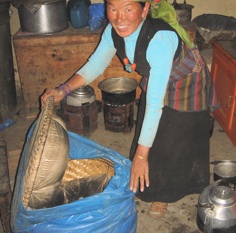
Heat-retention cooking basket introduced by Allart Ligtenberg in Nepal.
- February 2013: Twenty years of Solar and Green Cooking in Nepal - Allart Ligtenberg, founder of the Friendly Appropriate Solar Technologies (FAST) volunteer network, reflects on the progress made with promoting different aspects of integrated cooking throughout Nepal. A further integrated approach of "Green" solutions offered complete health, energy, environment-friendly solutions by adding solar space heating, photo-voltaics, efficient LED lighting, composting toilets, and biomass briquettes from waste for fuel. After joining the Rotary Club of Los Altos, California in 2002, Allart organized and participated in twenty-two Rotary Matching Grant programs in ten years (eighteen for Nepal, the others for Indonesia and Afghanistan).
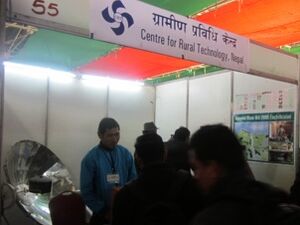
CRT/N participated in the two-day exhibition at Energy Week.
- February 2013: The Center for Rural Technology, Nepal (CRT/N) recently exhibited a parabolic solar cooker and other renewable technologies at the “Green Solution Fair”, organized by ICIMOD, at Knowledge Park, Godavari, Lalitpur in December 2012. . The objective of the fair was to demonstrate various green technologies and raise awareness among students, researchers, and the general public. CRT/N demonstrated the parabolic cooker by boiling eggs and potatoes, which was found fascinating by the attendees. Similarly, CRT/N also participated in the two-day exhibition at Energy Week, organized by the Alternative Energy Promotion Center (AEPC), to demonstrate the parabolic solar cooker again, along with a number of other renewable technologies. The solar cooker drew the attention of most of the visitors.
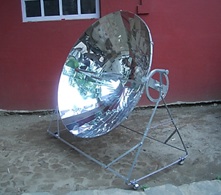
The SK-14 parabolic solar cooker
- February 2013: the government of Nepal, working through the Alternative Energy Promotion Center (AEPC), has supported the promotion of about 600 solar cookers, mostly the SK-14 parabolic cookers, and has offered incentives to help with purchasing them. The Center for Rural Technology (CRT/N) in collaboration with its sister concern, manufacturing company Gramin Urha Tatha Prabidhi Sewa Kendra (RETSC), have taken a lead role in this promotion and dissemination of cookers. With this assistance, they hope to able achieve the project goals. Similarly, AEPC/NRREP with the support from stakeholders is planning to disseminate a number solar cookers, in the newly formed NRREP, over a five year period by conducting workshops, seminars, and demonstrations.

Solar cookers in the Himilayas

Solar cookers in the Himilayas
- July 2010: Exodus travel group has managed to install several parabolic solar cookers in the Himalayas, at the gateway to the Everest region. An effort to help promote sustainability and provide a step towards limiting deforestation. More Information and photos...
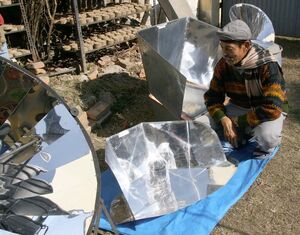
Sanu Kaji Shrestha and FoST promote several types of solar cookers, as well as fuel-efficient stoves that burn special briquettes made from agricultural and industrial waste.
- March 2008: The BBC’s annual World Challenge competition honors individuals and organizations that make a difference through enterprise and innovation at a grassroots level. The top 12 projects were promoted on the television program BBC World and in Newsweek magazine, followed by a public voting period. Solar cooker promoter Sanu Kaji reports that his organization, Foundation for Sustainable Technologies (FoST), was a top three finalist, winning $10,000 for its Cooking Without Gas project. The project was selected over nearly 1,000 others. Kaji Shrestha is grateful for the votes and support from the solar cooking community. In a letter to Solar Cookers International, he wrote, “Part of the credit goes to you and your solar cooking network for lobbying, and untiring support in our efforts.” Congratulations to Kaji Shrestha and FoST for this well-deserved honor!
- December 2007: FoST of Nepal is one of the 3 finalists in the World Challenge 2007! As runner up FoST has won $10.000 in the global competition organized by BBC World, Shell and Newsweek.
- July 2007: Foundation for Sustainable Technology (FoST) celebrated its fifth anniversary in April. FoST designs, develops and disseminates low-cost, adaptable products that improve the quality of life of Nepal’s rural and urban poor. FoST is among 12 finalists, selected from a pool of nearly 950 applicants, for the "World Challenge 2007." The selected FOST project is called "Cooking without Gas" and is summarized on the World Challenge Web site as follows: "In 1995, Sanu Kaji Shrestha ran out of cooking gas. So too did nearly everyone else in Kathmandu, as a countrywide shortage set in. Demand was so great Sanu had to take three days off work to queue up for more fuel. This first-hand experience of his country’s dependence on external energy supplies set Sanu thinking. He began to look into sustainable energy technologies for the domestic market, researching existing designs and adapting them for the Nepalese market. In 2001 he retired from his day job to concentrate on bringing low-cost, high-efficiency energy technologies to Nepal’s rural and urban poor. Measures developed to date include simple yet ingenious solar cookers and briquette presses to make smokeless fuel from waste materials." The World Challenge competition honors individuals and organizations that make a difference through enterprise and innovation at a grassroots level. The finalists will be featured on BBC World television and in Newsweek magazine. The winner will receive a $20,000 prize. An excellent new documentary film by Gorp Productions showcases the work being done by FOST, with a focus on its efforts to promote smokeless briquette cook stoves and solar cookers.
- April 2007: The government of Nepal has adopted a rural energy policy aimed at reducing rural poverty and protecting the environment. The government hopes to encourage local organizations, nongovernmental organizations and cooperatives to develop a variety of new energy sources such as micro hydro, wind and solar. According to solar cooking promoter Sanu Kaji Shrestha, the government has recently increased its subsidy for some parabolic-type solar cookers to 4000 rupees per unit, while there also is a 50% subsidy on some solar box cookers. However, he says it is difficult to fulfill the government’s criteria for receiving subsidies. He estimates there are about 2500 solar cookers distributed in rural communities so far.
- November 2006: Ten years on, nearly 100,000 Bhutanese refugees going solar
- March 2006: The Centre for Rural Technology, Nepal is promoting solar cooker use by lodge owners and other entities involved in eco-tourism. With support from Germany-based Wuppertal Institute for Climate, Environment and Energy, 200 SK-14 parabolic solar cookers will be distributed in the country, reducing energy expenses and promoting the use of solar energy through eco-tourism. Contact: Ganesh Ram Shrestha
- March 2006: Vajra Foundation Nepal (VFN), in partnership with United Nations High Commissioner for Refugees (UNHCR), will receive over $850,000 from Dutch Postcode Lottery to expand its solar cooker program to six additional Bhutanese refugee camps. VFN’s first project, launched in 1998, has benefited over 2,000 families in Beldangi refugee camp. The expanded program will allow refugees to make nearly 7,500 solar cookers, to be used on a shared basis by over 14,000 families. Each family will also receive two cooking pots and a retained-heat cooker. Stichting Vluchteling and Vajra Foundation Holland helped procure funds.
Climate, culture, and special considerations
Solar Cookers International has rated Nepal as the #12 country in the world in terms of solar cooking potential (See: The 25 countries with the most solar cooking potential). The estimated number of people in Nepal in sunny areas with fuel scarcity in 2020 is 6,000,000.
In Nepal, over 80 % of the total energy consumption comes from traditional energy resources. Biomass being the major contributing energy sector in Nepal, more than 75 % of the energy is supplied by firewood alone followed by 9.24 % from petroleum products, 5.74% from animal waste, 3.75% from agricultural residue, 3.53% from coal, 1.47% from electricity and 0.48% by renewable resources. The sectoral energy consumption pattern shows that the residential sector energy consumption is more than 80 % while the agriculture and others are the least energy consuming sectors. According to Water and Energy Commission Secretariat report of 1995 carried out for energy end use perspective, it was reported that residential cooking alone accounts for 65%, space heating accounts for 8%, agro-processing 3%, water boiling 2%, lighting for 1% while others account for over 20% of the total energy consumption in rural household sectors. Biomass has thus been very important source of energy in the Nepalese perspective. With the recent emphasis on renewable energy, there are various opportunities for economic development using these renewable resources.
Patricia McArdle reports in February 2009 after her visit to Nepal:
- I asked the women about their cooking habits and fuel usage. In some cases the men tried to respond for them, but I insisted on hearing directly from the women. Their responses and my observations were the same at each of the sites where we conducted training. They said they rise at 4 am to start their fires and serve sweet green tea to their families in the morning. The first heavy meal of rice, dahl, spinach and seasonal condiments is served to the whole family between 9 and 10 am. They extinguish their cooking fires around 10 am and start them up again at 2 pm to prepare afternoon tea and the evening meal. Sweet biscuits, buffalo milk and curd are also consumed in the afternoon since they require no cooking.
- The second and final large meal is served between 6 and 7 pm and like breakfast consists of rice, dahl, spinach and seasonal condiments. The meals are served piping hot on metal plates. The women cook in large 7-8 liter pots, one for rice and one for dahl. Spinach is sautéed quickly in a shallow pan with oil and spices just before the meal is served. The women told me they use approximately 3 kilos of wood per day per person for cooking and heating water for tea. Wood currently costs 15 Nepalese rupees (20 cents U.S.) per kilo, a threefold increase over five years.
- I did not observe any families using wood strictly for heating. The locations where we stayed were between one and two thousand meters and temperatures at night didn’t drop below 40 degrees F. Daytime temperatures were mild. Ugan said this region gets quite hot during the summer monsoon season (June-August). I told him that in some countries the rainy season still has enough sunshine at mid-day bracketed by morning and afternoon downpours, to make solar cooking possible. He said conditions vary greatly throughout Nepal with its dramatic and rapid changes in altitude, terrain and weather.
- The women use cold water for laundry, bathing and dish washing. Although they complained of water shortages and are experiencing mild drought conditions until the monsoons begin in June, the villages have no indigenous systems for harvesting and saving the massive amounts of rain water that falls every year during the monsoon season.
- Because of this area’s national park status, trees cannot be cut down at will, although I saw stacked logs and branches everywhere and many women carrying huge bundles of sticks down the road on their backs.
See also
The history of solar cooking in Nepal
Allart Ligtenberg, is the American name most closely associated with the introduction of solar cookers in Nepal. His small organization, FAST (Friendly Appropriate Solar Technologies), mainly Ligtenberg himself, has dedicated endless hours to the cause. For a number of years, this engineer, now retired from Hewlett Packard, has spent three months in Asia, principally in Nepal. His dissemination program is as simple as ABC, he states: A for awareness creation, B for building infrastructure; and C for continuous follow-up and creating new links. In Nepal, he began the task of visiting government officials, universities, voluntary organizations, embassies, service organizations, until he finally reached the office of the Centre for Rural Technology, Nepal (CRT). They struck up a collaborative relationship that has held over a number of years and been productive in promotion of solar activity. Ligtenberg carries with him cookers, recipe books, "how to" manuals, reference books, etc. and works to create a full fledged program of training new cooks, follow up, and promotion modes, program evaluation, etc. CRT staff have taken the ideas up with so much enthusiasm that he calls them the "champions of solar cooking" in this country. In the CRT program, a wide variety of cookers are shown and demonstrated in use, earning good media coverage and attracting wide public attention.
Special attention has been paid in Nepal to the remote lodges that serve trekking tourists in the Anapurna and other mountain areas. With the growth of the tourism industry, considerable environmental degradation was seen in the form of shrinkage of forests and their wildlife populations, excessive trash dumped on the trails, water pollution even at high altitudes, and signs of global warming. Renewable energy usage is strongly encouraged by the government, and many smaller lodges are now equipped with solar water heaters and solar food dryers. Solar cooking is a natural here. With high altitudes and thus little to impede the sun's rays, household size parabolic devices, or even larger ones, are very appropriate for these installations.
A number of such installations are is use, as described by Dieter Seifert of EG Solar, the German distributor of these models, on trekking trails in the Mt. Everest area, in Sagarmatha National Par, and a number of schools. The same type of parabolic is in use in Dhullikhel Hospital in Katmandu, where four such units provide hot water for patients.
In 1994, an organization from Finland, Technology for Life, conducted a series of solar experiments and evaluations of their potential for Nepal. Their search was for devices which would fit the needs of "near-subsistence" economies such as Nepal. They tried box cookers and home made parabolics but found that the cdst of all was out of reach of many, as poor quality was not acceptable and good quality not affordable. Not a dilemma found only in Nepal, but a rather common scenario. Another group is also at work in Nepal, the Foundation for Sustainable Technologies (FoST). This group is a recently established NGO with the goal of widely promoting and disseminating sustainable technologies to improve the quality of life of Nepalese people. They support a wide range of solar technologies and some others such as the haybox and fuel efficient stoves. Quickly after their founding, some of the members were setting up demonstrations in various parts of the country. Their goals are ambitious and long range in nature. However, the organization is too new to-have as yet much of a track record.
Solar cooking has also been initiated in camps serving the large population of refugees from Bhutan currently resident in Nepal. In one or more of these camps, a program funded by the Vajra Foundation mounted solar cooking programs in refugee camps. The Project was run by a man named Maarten Olthof who distributed 400 box cookers of the ULOG type (slanted top) in the camps. Working cooperatively with CRT (and Ligtenberg, also of Dutch origin), Olhof also worked in a rural area in the Katmandu Valley, near the capital city, conducting demonstrations and training. He hopes to involve more organizations, such as Rotary International, in these efforts.
Cookers of the parabolic type are also known to have been promoted in Nepal by the IBEU group, located in Germany at Julich. The device they used in Nepal is one with thermal storage capacity, accomplished with reflector plates, a steel vessel filled with pebbles, and vegetable oil as a heat transfer means. The devices are highly efficient, and retain heat for up to one day.
Substantial public awareness about solar cooking must be advanced in Nepal compared to many countries, given the number of places in the country where solar cookers are in use. But they are clearly far from a common sight, perhaps because the types of cookers in use are mostly on the expensive end and thus require some type of subsidy scheme to be available for to poor people. One niche, for solar cooking is almost certainly found in services for the tourist trade, since it both reduces cost to providers and reduces damage to the valuable environment.
Resources
Reports
- July 2013: Background Paper for Clean Cooking Market Place 2013, Nepal - Saroj Rai, Senior Renewable Energy Advisor, SNV
- January 2013: Solar Cooking with Integrated Systems - FOST
- December 2007: Conference paper: Integrated Strategies to Solar Cooking/Water Pasteurization, that Include Other Sustainable Technologies that Advance MDG's in Nepal
- July 2006: Promotion of Solar Cookers for Eco-Tourism Development in Nepal - Ganesh Ram Shrestha
- March 2005: Towards sustainable relief-assistance - Applicability of the sunny solution- Vajra Foundation Nepal
- 2003: Energy Hunters of Nepal (Or how two Rotary projects (COG 2152 and NOG 468) are providing a village in Nepal with a new energy source)
Audio and video
- August 2014:
Humanist Community Forum (2014-08-24) Solar Cooking and Other Green Technology Projects in Nepal (Allart Ligtenberg)
In 1992, Allart Ligtenberg retired early from his Hewlett-Packard engineering manager’s job to follow his dream of disseminating solar cooking/water pasteurization and other renewable energy technologies in developing countries. Allart started long-term solar cooking programs in Nepal, and each year he spends 2-3 months in Nepal to follow up on these programs.
- July 2014:
- July 2014: Alan Bigelow's presentation "Solar Cooking on a Trek in Nepal" delivered at the SCInet convention in July, 2014 included the video below.
- August 2013:
Allart Ligtenberg
Presented at Solar Cookers International's Shine On:2013 event, Allart Ligtenberg explains various solar cooking projects he has been involved with.
- February 2010:
Solar Cooking Project in Nepal by Stichting Vajra.wmv-0
Solar cooking project in a Bhutanese refugee camp in 2007 with [http://solarcooking.org/m.
- January 2009:
Articles in the media
- March 2013: Hewlett-Packard alum sets out to change world with Nepal solar project - MercuryNews.com
Disaster Assistance Files and Links
- April 2014:Four-Block Stove (चार ब्लक चुलो) - Printable one-page plans for the construction of a rocket stove out of concrete blocks.
Contacts
The entities listed below are either based in Nepal, or have established solar cooking projects there:
SCI Associates
- Main article: Solar Cookers International Association








